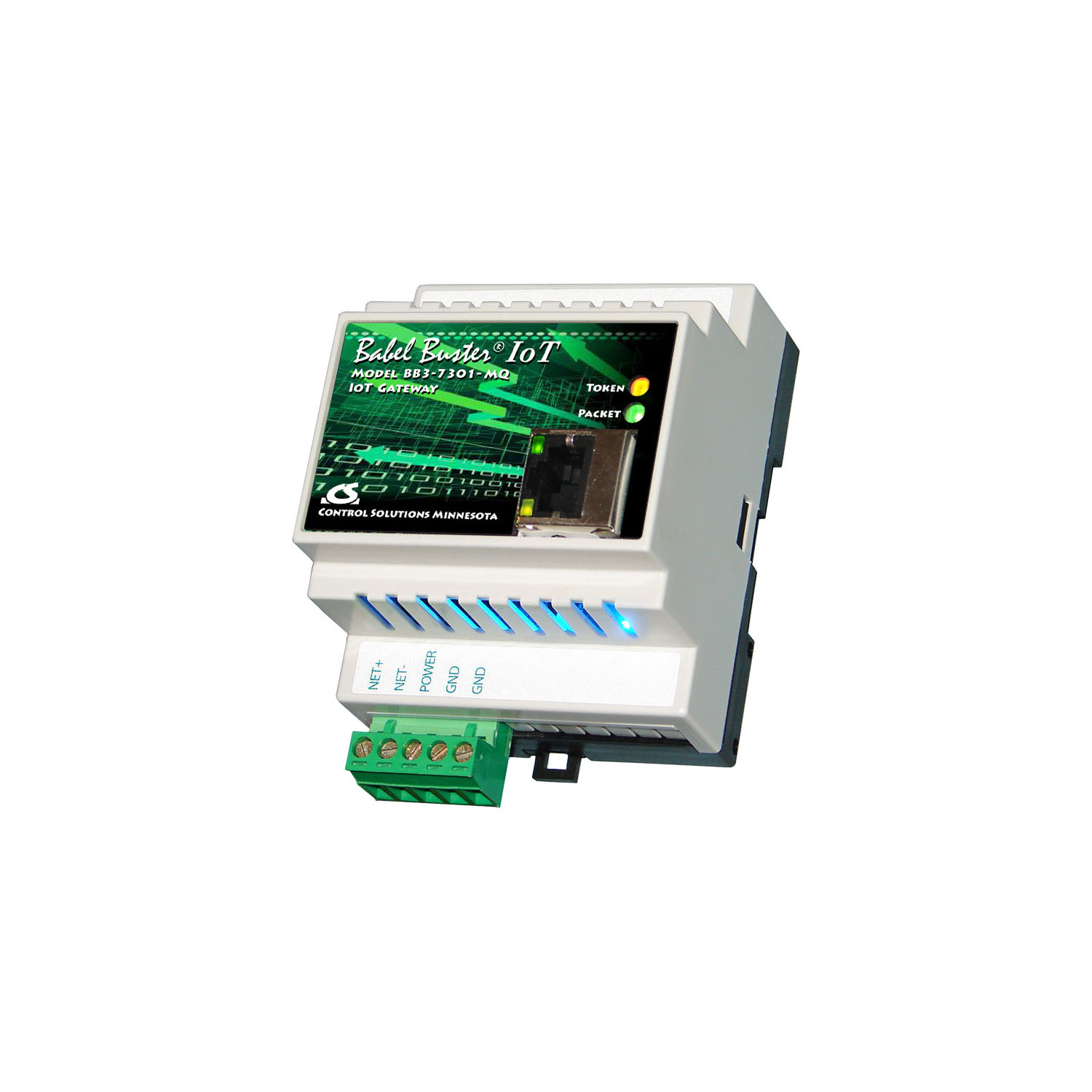Babel Buster BB3-7301-MQ BACnet to MQTT IoT Gateway
$739.00
Control Solutions’ Babel Buster BB3-7301-MQ BACnet to MQTT Gateway turns any BACnet device into a Thing on the Internet of Things. Gain instant access to a wide range of machine learning and AI capabilities, a wide range of data storage and analytics, and a variety of event handling and notification capabilities.
Overview
Control Solutions’ Babel Buster BB3-7301-MQ BACnet to MQTT Gateway turns any BACnet device into a Thing on the Internet of Things. Gain instant access to a wide range of machine learning and AI capabilities, a wide range of data storage and analytics, and a variety of event handling and notification capabilities.
The BB3-7301-MQ includes everything necessary to connect to Amazon Web Services (AWS) IoT support using MQTT. Once the IoT connection is made, your BACnet data can make its way to an AWS database, AWS notification services (e.g. email alerts), and a variety of analytics tools including QuickSight which makes it quite easy to quickly graph your data.
The Babel Buster BB3-7301-MQ BACnet to MQTT gateway will poll one or more BACnet IP and/or BACnet MS/TP devices, collecting data from the list of objects you provide. Based on rules you create, the BB3-7301-MQ will decide if and when to publish that data to the MQTT broker (server). You can also configure the BB3-7301-MQ MQTT client to subscribe to data coming from the MQTT broker, which you can then write out to BACnet devices to manage setpoints and the like.
Cloud Not Required!
The BB3-7301-MQ is also suitable for stand-alone remote monitoring use. The BB3-7301-MQ includes alarm monitoring with email notifications using its internal secure email client, local data logging with CSV files emailed to you instead of sending data to the cloud, and a real time scheduler for date and time scheduling.
Feature Highlights
• MQTT Client supporting AWS IoT Core
• Simple template based setup of MQTT Publish and Subscribe
• BACnet IP to MS/TP Router and Gateway
• BACnet Client and Server
• Secure local email client
• Local data logging
• Real time scheduler
• User HTML support for adding custom web pages
• Configure via secure web pages
• FCC, CE Mark, UL 916 Listed
Description
Allow Any BACnet Device to Play as a “Thing” on the Internet of Things!
The MQTT “publish” action in the BACnet to MQTT gateway, in controls terms, is most closely associated with sensors. Your hardware has collected sensor data, and you want to send that sensor data to a server or to other control devices. To send that data, you “publish” it to the MQTT broker.
The MQTT “subscribe” action, in controls terms, is most closely associated with actuators. The “subscribe” action would also be associated with control setpoints. You can never force data into a device via MQTT. The device, in our case the BB3-7301-MQ, must subscribe to the source of data effectively asking to be informed of changes. Once you have subscribed to an MQTT source of data, then when received, you can use that data to control actuators or update setpoints.
One of the many things you can do with data that has been published to the AWS MQTT broker by the Babel Buster BB3-7301-MQ is analyze and visualize the data. The graph illustrated above represents data published by an BB3-7301-MQ, and the steps taken to get this graph – without writing any program code – are outlined in the user guide.
The data flow in the BB3-7301-MQ BACnet to MQTT gateway is illustrated below. Data is collected from BACnet devices by the BACnet engine which stores that data in its local objects. The BACnet data is automatically updated on a continual basis. Meanwhile, the IoT engine is looking at its set of publish and subscribe rules to decide when to publish data from the local objects to the MQTT broker. These rules are also created by the user and data will be published according to the criteria set up by the user.
The BB3-7301-MQ includes BACnet MS/TP and BACnet IP client and server. Maps created via templates in the BB3-7301-MQ’s web UI will read and write other BACnet devices, copying their data to local objects when read, or sending data from local objects to those devices when written.
BB3-7301-MQ Works Equally Well as Stand-Alone Remote Monitoring Device
The BB3-7301-MQ includes a secure local email client that will directly email you notifications of alarm events. The event rule template has all of the same power and flexibility as the MQTT publish template. You can implement stand-alone remote alarm monitoring on multiple data points, and send different notifications to different people.
The email message template lets you fully customize the message that is sent. You can use any email account including Gmail to send emails from the BB3-7301-MQ. The template includes variables which insert real time data from the BB3-7301-MQ as the email is sent.
The BB3-7301-MQ includes local data logging capability that can be used instead of sending data to the cloud. You select which data points are logged to a local CSV file. This file is then emailed to you periodically. You select logging rate and when files should be sent. You also have the option of logging at a slower rate most of the time, but then log faster when an event of interest is in progress.
The Babel Buster IoT Gateway becomes more useful when control functions can be combined with monitoring. One element of control that is often useful is the ability to schedule things to happen at certain times on certain days. The scheduler makes that possible.
Scheduling is done in a very generic and simple way. A object you select will change value according to a schedule you provide. From there, you can use the client to write that object to some external BACnet device to cause action according to your schedule.
Specifications
• MQTT Client supporting AWS IoT Core
• Simple template based setup of MQTT Publish and Subscribe
• Secure local email client for stand-alone notifications
• Local data logging for stand-alone remote monitoring
• Real time scheduler
• BACnet IP to MS/TP Router
• Configured or learning, I-Am route learning, I-Am-Router route learning
• Slave proxy to support MS/TP slave-only devices
• Client/Server gateway for remapping BACnet objects
• Read/Write any standard BACnet objects as a Gateway
• Up to 5,000 objects
• Analog, Binary, Multi-State object types
• Input, Output, Value objects
• Commandable BACnet objects implement priority array
• BBMD, COV support
• Configure via web pages, HTTP and/or secure HTTPS
• Flash file system for XML configuration files, SSL certificates
• Online help, Quick Help section at bottom of every web page
• Password protection for web log-on and ftp
• Field upgradeable firmware upload via ftp
• DHCP or static IP address, IPv4 and IPv6 support
• Hardened EIA-485 transceiver for BACnet RTU
• Powered by 10-30VDC or 24VAC 50/60 Hz
• Power Consumption: 0.1A @ 24VDC
• DIN rail mounting, 100mm H x 70mm W x 60mm D
• Pluggable screw terminal block for power & RTU network
• Operating temperature -40°C to +85°C; Humidity 5% to 90%
• FCC Class A, CE Mark
• Listed to UL 916 and (Canadian) C22.2 No. 205-M1983
Maximum Object Counts and System Capacities for BB3-7301-MQ
• BB3-7301-MQ allows user allocation of memory resources. Memory capacity will not support maximum counts of everything possible, but maximum count limits are set high so that you can allocate resources where you need them.
• Maximum BACnet object count 5000
• Maximum IoT Thing Attributes 100
• Maximum BACnet device count 200
• BACnet Client read map count 5000
• BACnet Client write map count 5000
• Maximum event rules 1000
• Maximum weekly scheduler events 1000
• Maximum on-demand scheduler events 1000

